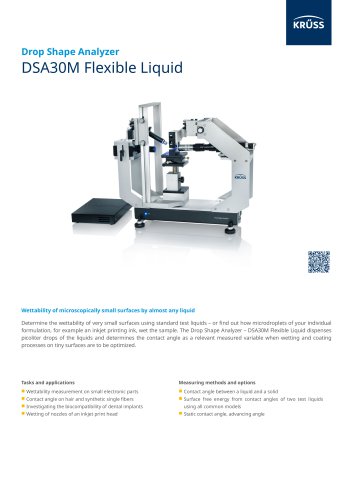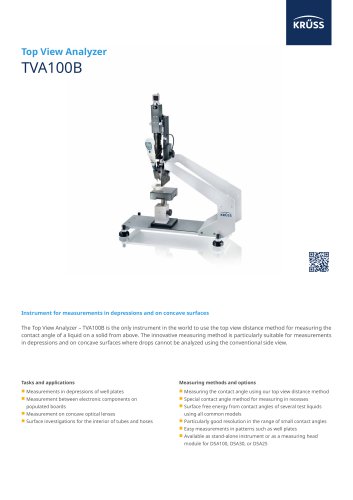 Website:
KRÜSS GmbH
Website:
KRÜSS GmbH
Group: Krüss
Practical Contact Angle Measurement (5) – Custom-made models: from contact angle to surface free energy
1 /
5Pages
Catalog excerpts

Technical Note Practical Contact Angle Measurement (5) Technical note: Industry section: Drop Shape Analyzer – DSA100 Method: Keywords: methods, contact angle, sessile drop, surface free energy, interfacial tension Custom-made models: from contact angle to surface free energy The determination of the surface free energy (SFE) of a solid is the ultimate in contact angle measuring techniques. The method provides the user with important information about the material surface, such as its wettability and adhesiveness. In order to plan a measurement and draw the correct conclusions from the results a good knowledge of the scientific models upon which these are based is useful. In this final part of the Newsletter series on contact angle measurement the most important models for determining the surface free energy (SFE) are described; these are used in practice (and in KRÜSS software). In addition to the proper use of the models, it is also concerned with the practical aspects of SFE determination: selection of suitable test liquids, suitable ambient conditions and the consequences arising from the properties of the solid surface. About models The keyword “model” may perhaps have a sobering effect on one reader or the other: an SFE value obtained from contact angle data is not knowledge about a solid that is carved in stone, but rather an interpretation of its behavior within the framework of the model used. Strictly speaking, this applies to any scientific statement. However, many formulations from the natural laws are so familiar to us that we are now no longer aware of their model character. Fig. 1: Copernicus’ model of the solar system – since “relativized” by Einstein The measure for the meaningfulness of a model is its consistency, the possibility of explaining observed phenomena in as simple a way as possible and of making predictions that can be confirmed empirically. This means that it is a good idea for users of the contact angle measuring technique to familiarize themselves with the theory – and limitations – of the models used. KRÜSS GmbH | Borsteler Chaussee 85 | 22453 Hamburg | Germany | ww
Open the catalog to page 1
Surface tension and surface free energy Surface tension (ST in the following text) and SFE are equivalent physical terms; the first is conventionally used for liquids and the second for solids. Zisman [13] plotted the cosine of the contact angle against the surface tension of the corresponding liquid. He defined the extrapolated value for cosθ=1 (θ=0°) as In a liquid the surface tension results from the fact that a molecule at the surface is in contact with fewer neighboring molecules that it can interact with than in the bulk of the liquid. Remaining at the surface is less attractive for...
Open the catalog to page 2
Wu Wu [11;12] stated that for a low SFE the harmonic mean between the particular fractions (disperse and polar) often provided more reliable values than the geometric mean. The use of the harmonic mean corresponds to the following equation: The empirical basis for this is provided by interfacial tension measurements between polymer melts, i.e. materials with a predominantly low surface tension for the individual phases. Accordingly the Wu method is mostly used for SFE calculations for polymers with low surface free energies (up to 30-40 mJ/m2). Fig. 3: Schematic diagram of phase contact in...
Open the catalog to page 3
The work Neumann et al [6;7] was carried out in a different field; their theory entered the SFE determination as an “Equation of State”. According to the thermodynamic approach of Neumann, breaking down the ST into interactive components does not hit the target. The not undisputed [see 4,32] theory does not need any differentiation of interactive components and requires only one liquid with a known ST – the advantage lies in the rapid access to an SFE value. As Neumann has mainly derived his equation from results for non-polar solids with low surface free energies, his approach can...
Open the catalog to page 4
In contrast to liquids, hardly any molecules change places in a solid; this means that the surface free energy describes a static condition of the solid and not a dynamic equilibrium between mobile particles. As a result, the SFE of a chemically inhomogeneous solid may depend on the place of measurement. In addition, the macroscopic structure of the surface influences the contact angle. R. J. Good, Contact Angle, Wetting and Adhesion: a Critical Review. In: K. L. Mittal (Hrg.): Contact Angle, Wettability and Adhesion. Festschrift in Honor of Professor Robert J. Good. Utrecht 1993, S. 3-36....
Open the catalog to page 5All KRÜSS GmbH catalogs and technical brochures
-
DROP SHAPE ANALYZER – DSA30M
2 Pages
-
DSA30M Flexible Liquid
2 Pages
-
Product Overview 2025
84 Pages
-
Tensíío
2 Pages
-
Ayríís
2 Pages
-
FORCE TENSIOMETER – K20
2 Pages
-
FORCE TENSIOMETER – K6
1 Pages
-
TOP VIEW ANALYZER – TVA100B
2 Pages
-
DROP SHAPE ANALYZER – DSA30
2 Pages
-
DROP SHAPE ANALYZER – DSA30R
2 Pages
-
Drop Shape Analyzer DSA25
2 Pages
-
DROP SHAPE ANALYZER – DSA100
2 Pages
-
Dynamic Foam Analyzer DFA100
2 Pages
-
DSA100, DSA30, EasyDrop
5 Pages
-
DSA100, DSA30
4 Pages
-
DSA100
3 Pages































